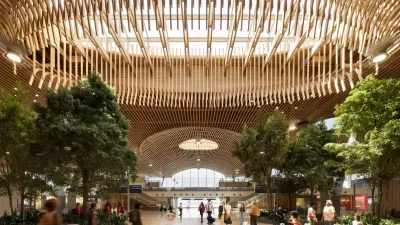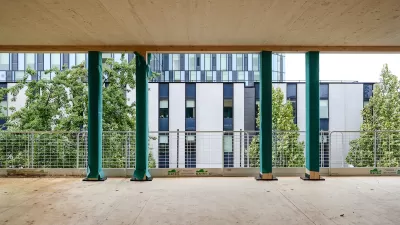Mass timber is called the first new way to construct tall buildings in 100 years.
"New structural systems come along rarely, and when they do, they usually wind up transforming cities," writes Justin Davidson.
The potential scale of such technological innovations is why planners should take notice of the advancements in wood construction. After millennia of two types of wood construction, architects have recently added a third technique: "sandwiching layers of wood and adhesive, yields cross-laminated timber (CLT), a kind of super-plywood that comes in immense slabs as long as a bowling lane and as thick as 12 inches."
"When steel replaced iron at the end of the 19th century, the path from the ten-story Home Insurance Building in Chicago to the Empire State Building took less than 50 years. Today, mass timber (the umbrella term for CLT and glulam) could have a similarly radical impact, because it gives architects and builders a chance to think in fresh ways," writes Davidson.
FULL STORY: Imagining a Wooden Skyline

Planetizen Federal Action Tracker
A weekly monitor of how Trump’s orders and actions are impacting planners and planning in America.

Restaurant Patios Were a Pandemic Win — Why Were They so Hard to Keep?
Social distancing requirements and changes in travel patterns prompted cities to pilot new uses for street and sidewalk space. Then it got complicated.

Maui's Vacation Rental Debate Turns Ugly
Verbal attacks, misinformation campaigns and fistfights plague a high-stakes debate to convert thousands of vacation rentals into long-term housing.

In California Battle of Housing vs. Environment, Housing Just Won
A new state law significantly limits the power of CEQA, an environmental review law that served as a powerful tool for blocking new development.

Boulder Eliminates Parking Minimums Citywide
Officials estimate the cost of building a single underground parking space at up to $100,000.

Orange County, Florida Adopts Largest US “Sprawl Repair” Code
The ‘Orange Code’ seeks to rectify decades of sprawl-inducing, car-oriented development.
Urban Design for Planners 1: Software Tools
This six-course series explores essential urban design concepts using open source software and equips planners with the tools they need to participate fully in the urban design process.
Planning for Universal Design
Learn the tools for implementing Universal Design in planning regulations.
Heyer Gruel & Associates PA
JM Goldson LLC
Custer County Colorado
City of Camden Redevelopment Agency
City of Astoria
Transportation Research & Education Center (TREC) at Portland State University
Jefferson Parish Government
Camden Redevelopment Agency
City of Claremont





























